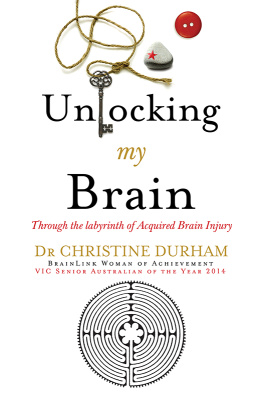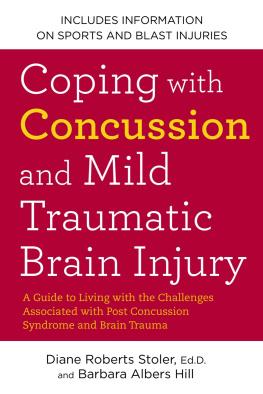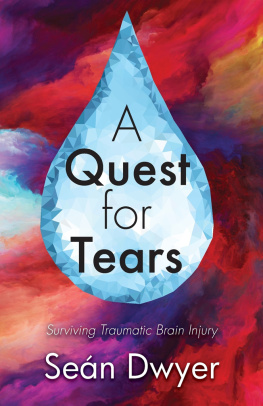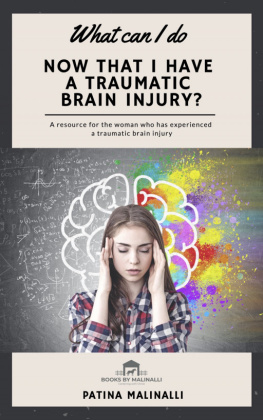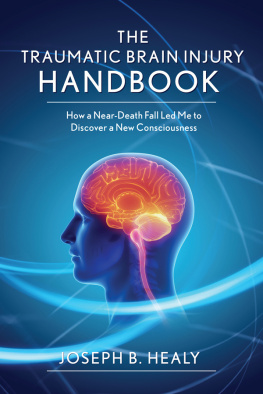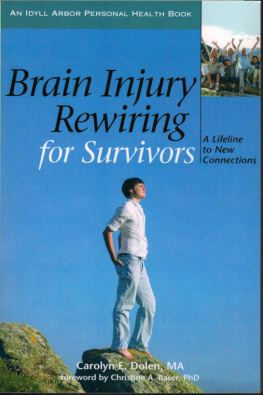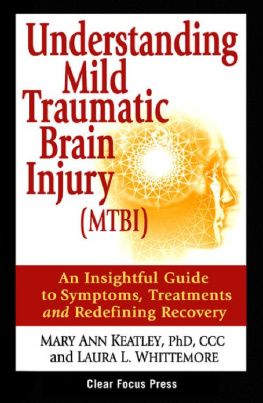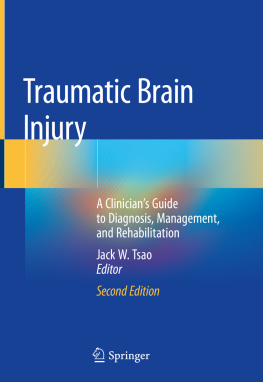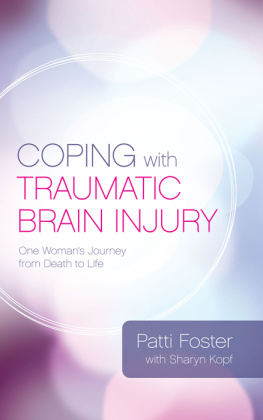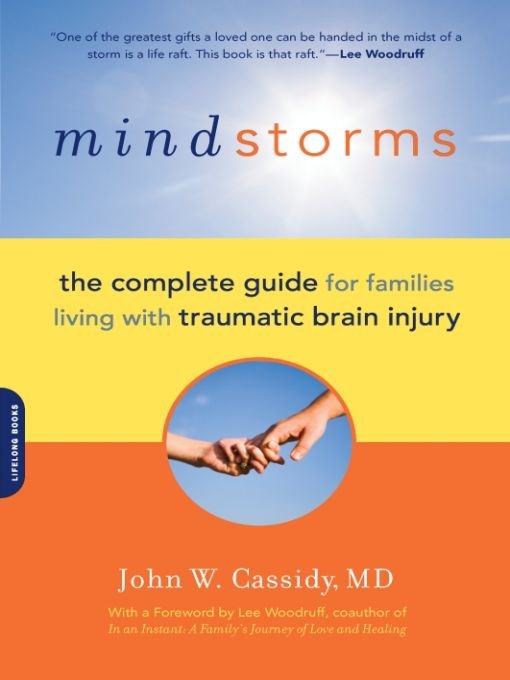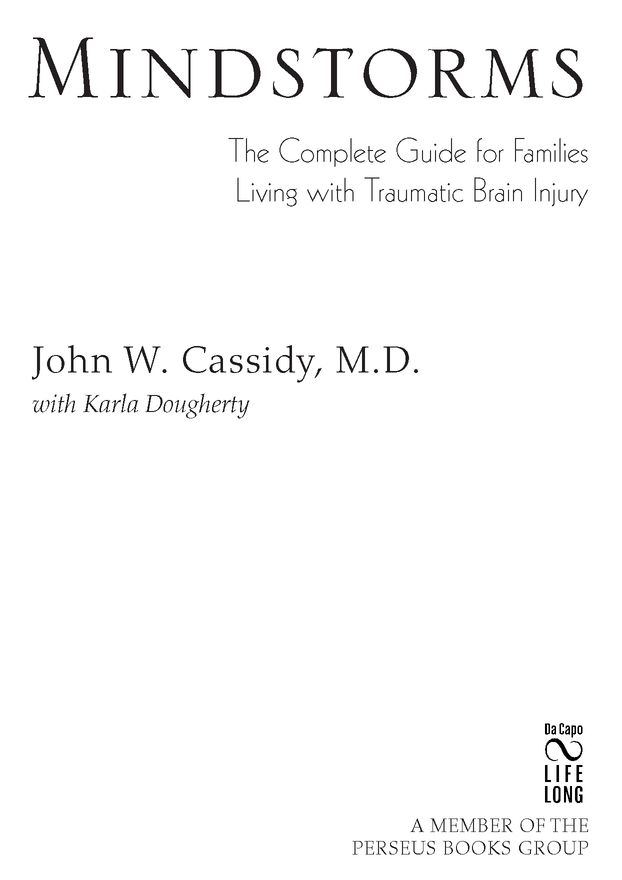Table of Contents
This book is dedicated to those who took the leap of faith:
RAYMOND D. ADAMS, MD; CHARLENE MADISON CASSIDY, PHD;
BRUCE M. COHEN, MD, PHD; SHERVERT FRAZIER, MD;
AND NORMAN A. ZOBER, PHD.
FOREWORD
A brain injury is a life-altering experience. For some, the changes are subtle, hidden. For others, the differences can be more dramatic, causing alterations in personality, thought, and movement that are permanent.
Most brain injuries happen in seconds: a car accident, a stroke or aneurism, a fall or sports injury. In my familys case it was a bomb on a dusty road in Iraq.
My husband, Bob Woodruff, an anchor of ABC News, was embedded with the military near Baghdad during the Iraq War in 2006. While he was standing in a tank, but with his head exposed through a hatch, a remote-controlled 155 mm shell exploded at close range. The force of the blast and the shrapnel blew off Bobs helmet and crushed his left temporal lobe, also injuring the left side of his face and neck.
In an instant our lives became focused solely on Bobs survival as he lay in a coma for thirty-six days, battling back from the injury and then succumbing to sepsis and pneumonia following numerous surgeries. Like so many before me I became a full-time caregiver, balancing my childrens needs against those of my husband and praying, hoping, believing that he would have a good outcome, despite the grim prognosis. During this time, I became determined to get as much information as I could.
For anyone involvedwhether patients or their loved onesnavigating the journey of brain injury can be frightening, complex, and often discouraging. There are far too few beacons of information, hope, and realism. I initially picked up the manuscript of this book expecting to find something geared more to professionals, something that would speak in mostly inaccessible language and foreign terminology.
What I found instead was a breath of fresh air among the many other publications I have seen. Mindstorms is a useful, interesting, and informative manual, almost breezy in its comfortable ability to communicate with the layperson. I read it cover to cover. One of the greatest gifts you can be handed in the midst of a storm is a life raft. This book is that raft. It offers families one comprehensive place to access all the information, knowledge, and answers to common questions they will need by laying out easy-to-follow examples, explanations, stories, analogies, and even diagrams.
This book accomplishes something very difficultit demystifies the most complex and individual organ in our bodies. And it does so in a tone that is not overly cheerful, full of doom and gloom, or patronizing. Above all, I found that to be comforting.
We will never be able to eradicate brain injuries from humanity. There will always be accidents, injuries, violence, and the unpredictability of life. But one thing that can ease the journey is a book like this, offering some good sense out of what is often, especially initially, a senseless situation.
Lee Woodruff, coauthor with Bob Woodruff of In An Instant: A Familys Journey of Love and Healing
INTRODUCTION
Jessica Collins, a professional aerobics instructor who worked out six times a week, had been married to Kyle for a year and still felt like a newlywed. Around noon on a hot August day, she was on her way in her sports coupe to meet Kyle for lunch.
And then her life changed forever.
A pickup truck going seventy miles per hour hit her car broadside on the drivers side, knocking Jessica unconscious. She was rushed to the hospital with serious internal injuries, including a damaged spleen, a broken collar-bone, and a massive brain injury that affected both sides of her brain.
Ill never forget that day as long as I live, said Jessicas mother, Laura. I lived two hours away and had just registered to go back to college. Kyles mother called me with the news, and I was in the car before we even hung up.
So many family members gathered at the hospital that one of the doctors let them wait in an empty conference room. Finally, a doctor came in and said, I want to talk to yall. Ill bring you in to see Jessica now, but you have to be prepared for what youre going to see. She may be unconscious for the rest of her life. She may never talk again.
Hours later, Jessicas brain began to swell up so much that a neurosurgeon had to drill two burr holes in her skull to relieve the elevated pressure. She was put into a deep coma with medications to give her brain a chance to heal. Although the doctors kept telling the family to prepare for the worst, Laura tried to focus on any positive sign, no matter how slight. If Jessica blinked, it was an improvement. If Jessica moved her head a millimeter at the sound of her moms voice, it was progress.
Enough, Jessica, Laura would whisper to her. Ive had it. Time for you to wake up. You have a strong body. I know you do. Tell your brain that this is what is going to happen: You are going to be Jessica again.
Slowly, very slowly, Jessica began her journey back. After a three-and-a-half-month stayfirst at the trauma center, and then at a long-term specialty medical hospitalshe was transferred to a rehabilitation facility, where she relearned basic routines, such as taking a shower, brushing her teeth, getting dressed, going by herself to the bathroom. Once she had these activities of daily living down, she was discharged, but she remained an outpatient for a year. Her biggest fear was that she would never have children.
Jessica couldnt remember the accident then and never will. In fact, she couldnt remember anything further back than her last birthday, a month before the accident. Laura began writing in a journal about Jessicas life before and after the traumatic brain injury, so that even if she couldnt remember the events, at least she would have a record of them.
Today, Jessica works out every other day in her home gym, lifting weights and riding a stationary bike. She has two children, who, she says, are perfect (of course!). She loves to read Danielle Steele novels, and her mother drives her to the day-care center her daughter Haley attends, where Jessica works with other children part-time as a classroom aide.
Is Jessica the same person she was before the accident? No. She slurs her words when she gets nervous or tired. She drops things and has difficulty moving around in crowds. She still has short-term memory issues and cant drive a car. But Jessica has accepted her new life with its limitations. She is surrounded by love, and that makes up for a lot.
Jessicas tragedy is one of thousands that occur each yeareach one as unique as the person involved. Traumatic brain injuries are always caused by a number of pathologic changes to the brain, depending on the type or types of injuries involved in the initial trauma. In medical terms, these pathologic changes are referred to as the underlying neuropathology. Some of these end results of trauma are caused by the same neuropathology that afflicts individuals who have experienced non-trauma-related disorders such as strokes, heart attacks (myocardial infarctions), or near-drowning.
For example, strokes that result from abnormalities occurring in the blood vessels supplying the brain with blood and oxygen are caused either by blockage or rupture of these blood vessels. Although under these circumstances the pathologic processes that impact brain functioning are not generally related to trauma, stroke-like syndromes are commonly seen following traumatic brain injuries when these same vessels are injured by externally produced forces that tear or compress them. Similarly, heart attacks or near drowning lead to deprivation of oxygen and blood flow to the entire brain. In the case of a full-blown cardiopulmonary arrest, the heart is unable to pump blood; in the case of near drowning, the lungs fill with water and prevent oxygen from reaching the brain. These conditions cause either hypoxemia or anoxia, which destroys large areas of brain cells when they do not receive enough


